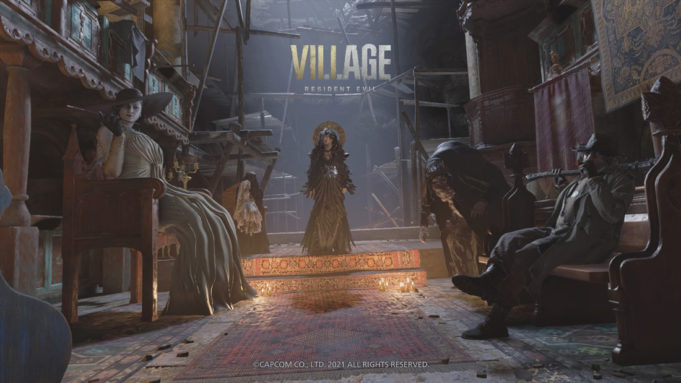Resident Evil 7 from 2017 was a welcome relief after the excesses of Resident Evil 6, returning the venerable survival-horror series to a focus on, well, surviving horror. Now, following successes with remaking Evils 2 and 3, Capcom continues the mainline series with Resident Evil Village, a sequel that ups the action from the previous entry and slightly dips the scares, but it still maintains the high standard the series is known for.
Taking place three years after 7, everyman protagonist Ethan Winters, after successfully rescuing his wife Mia during the previous game, has relocated to Europe with her and their newborn daughter Rose. This being a horror game, their happy family life lasts about 10 minutes before they’re attacked by longtime RE hero Chris Redfield no less and baby Rose is kidnapped. Ethan winds up in the titular unnamed village, a place out of a dark fairy tale nestled between snowcapped mountains. Players will have to help Ethan explore the village, fight monsters, and solve puzzles to rescue Rose.
While 7 was an exercise in intense, claustrophobic horror, Village is more combat-oriented, with numerous weapons to use and a plethora of enemies to battle. And if a more combat-heavy game set in a European village sounds familiar, it’s because the game is definitely invoking 2005’s RE4, wildly considered the series’ best entry. These callbacks also include a merchant named the Duke who can buy collected treasures, sell and upgrade weapons, and even sell a limited amount of ammo, a first for the series, and the return of the grid-based inventory system. However, while he can move faster and knock enemies back when blocking, Ethan is still a far cry from the super-soldiers of other series’ protagonists. He won’t be roundhouse kicking anyone or punching any boulders, so players will never feel overpowered. Combined with the more atmospheric and exciting levels and setting, the overall effect is a game that’s not as scary as its predecessor but is still thrilling throughout.
Another big change is the setting. The game swaps the Southern gothic, Texas Chainsaw Massacre-like tone of 7 for one inspired by folklore and gothic horror. The titular village, with its rustic houses, windmills, and a towering castle, looks like it could’ve come from a James Whale film, and the enemies are an eclectic collection of characters based on gothic horror tropes like vampires and ghosts but given the Resident Evil treatment (you know, slime and tentacles). The villains, from towering vampiric Lady Dimitrescu to brash mad scientist Heisenberg, are an engrossing and entertaining lot, and the standard enemies, the werewolf-like Lycans, are a cunning and dangerous improvement on the previous game’s Molded. It’s a blast to explore the intricately detailed and stylish levels and see just what new twists on classic monsters the game will throw at you.
Unfortunately, one area the game falters in is the scares. It lacks the oppressive mood of 7, and the focus on action takes away from the horror, but it’s not as action-movie-ridiculous as 6 (save for one boss fight, which is pure RE bombast). It still has its share of jump scares, and there are plenty of tense moments and dark corridors to brave. Segments where enemies stalk Ethan as he tries to explore and solve puzzles are as daunting as being hunted by Mr. X in RE2 Remake. However, there is one section of Village that, without hyperbole, stands out as not just one of the scariest moments of a Resident Evil game but in any game, period, and will test even the bravest of gamers.
One way the game doesn’t falter is with its story. Ethan is given more of a personality this time around, and without giving too much away, Village provides one of the most engaging stories in the series’ history and manages to even be quite touching at times. Yes, seriously, a Resident Evil game. Add in a reasonable play time, extra difficulties to unlock, and treasures to find, and Village invites multiple playthroughs as well. Beating it on any difficulty also unlocks the returning Mercenaries mode, which lets players test their combat skills in short, timed segments. There is also a multiplayer aspect, Re:Verse, allowing players to battle one another as series’ heroes and villains, due in July.
There are other minor hiccups like texture pop-in, and the combat, though fun, isn’t as refined as in RE4. And while it’s not as scary as the previous game, Village still proves to be a fun, exciting experience, one with plenty of action, thrills, replayability, and depth. And, without giving too much away, it stands to lead the series in an even more interesting direction.












